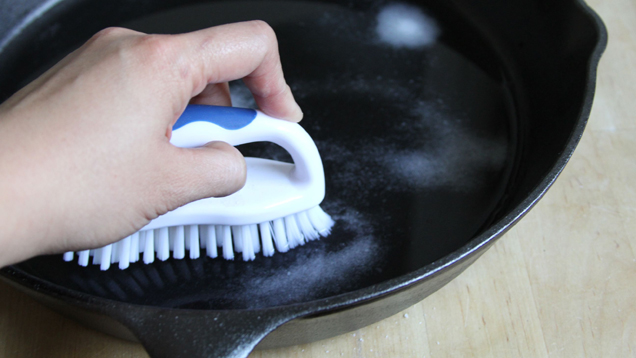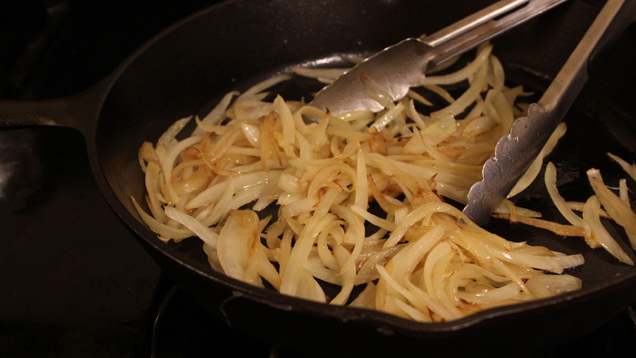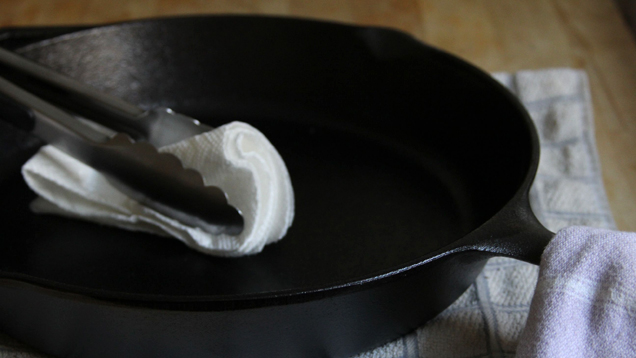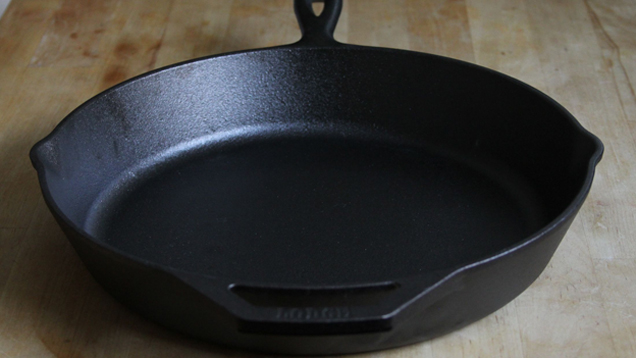We love pans — in particular, cast iron pans. If you don’t own one or or you haven’t used yours yet, here’s why you should start cooking with it regularly.
Let’s start with just a few reasons why we love cast iron pans. First of all, they’re inexpensive to buy and work with nearly every cooking and baking application. From an environmental standpoint, they’re free of chemical coatings, and actually add iron content to your food (a good thing). But best of all, a well-cared-for pan will stay with you longer than a life partner — and if you use it properly, it will only get better with age and time.
During cooking, oil will bonds to the surface of cast iron, making its surface increasingly nonstick. This process is known as seasoning. With a well-seasoned skillet, you can actually cook with less oil than in a regular pan — and the more you cook with your cast iron, the better it will perform.
How To Buy The Perfect Cast Iron Pan
The best cast iron panss are ones that have been passed down for generations, because they have had decades to develop a coat of seasoning that’s virtually nonstick. These pieces were made in solid, not sand, moulds, and polished after casting — a process no longer used today.
If you don’t have hundreds of dollars to drop on vintage cast iron, that’s perfectly fine too — buy a new one and start your own tradition. Any brand should work, but make sure you buy a pan that’s heavy and thick.
How To Care for Your Cast Iron
A newly-purchased cast iron pan, even if it’s pre-seasoned, isn’t going to have great nonstick qualities. Be sure to clean it thoroughly, scrubbing it with hot water and salt, then season it a few times by heating it over a large burner to dry, use a towel to saturate the surface with oil, and popping it into a hot oven for 20 to 30 minutes. Cook with it frequently, and with some patience, you’ll begin to see better nonstick results.

It’s essential to clean cast iron cookware properly. Once you’ve cooked with it, rinse it under hot water, scrubbing with a brush (or, if you need to more friction, a generous shake of salt). Soap isn’t necessary, but you can use it if you really want to. Most importantly: never, ever leave your cookware to soak in the sink. It will rust. Instead, dry it immediately, then put it on the burner to let moisture evaporate. Once it’s fully dry, add a few drops of oil (use one with a high smoke point), and massage the oil in with a towel until you’ve rubbed all excess oil off the pan. Check out the video above to see the process in action.
How To Cook With Your Cast Iron

Just about anything you want to do — searing, sautéing, baking, frying, braising — performs best in cast iron cookware. Cast iron Pans are the perfect size and shape for one-pan dishes like deep-dish pizza. They’re also deep and heavy-bottomed enough for deep-frying, so start perfecting your pan-fried chicken skills. Cast iron, with its conductive heat, can get screaming hot in a way that stainless steel can’t, which means there’s no better way to get a sear on a thick steak, or a good crust on a pizza.
One thing to note: unless your cast iron is extremely well-seasoned, acidic foods, like tomato sauces, wine and citrus juices aren’t a good match for your cast iron. If they’re going to be cooking in your pan for a long time, they will likely impart a metallic taste to your food, and create a spotty, dry, light-coloured surface. If this happens to you, restore your pan by reseasoning it until the surface looks black and smooth again.
Safely Store Your Pan

Cast iron performs best if it’s used frequently, but make sure it’s be cleaned, seasoned, and cooled before stowing it away. If you need to store it for a long period of time, try lining it with coffee filters before stowing it away. If you’ve improperly stored it, and you find it’s become rusted, restore it with vinegar (or, in dire situations, oven cleaner). You may find it has lost its seasoning and you need to baby it from scratch, but even in the worst scenarios, you’ll never need to go out and buy another cast iron pan.

Comments
3 responses to “Kitchen Tool School: The Amazing Cast Iron Pan”
Also, Flax seed oil is great for seasoning cast iron
Great way to add some iron if you are anaemic.
I have never used a cast iron pan before. Can someone point me in the right direction to buy a good one?
Really interesting about cat iron fry pans but can I buy one through you guys?
I only use lard. Not bacon fat. Pure lard has no salt. Oil will over time get sticky . If lard was good enough for my great grandmother then it is good enough for me and my cast iron. Us your cast iron for everything. Even 1 egg. keep it clean and free from left over cooked food. Use a stiff plastic brush to clean off any burnt food. Boiling water and then dry thoroughly. Store hanging up is best. But I have use put them in a cupboard with paper hand towel and a round of calico or old sheet between. Remember to seat them on an old tea towel so the bottom doesn’t mark the shelf.
I have got rid of all my coated cookware. A small fortune from top of the range. Not that they weren’t any good but because the coatings’ chemicals have been found in mother’s milk. I truly loved my non stick pots and pans but babies drink Mothers’ milk so those chemicals are going into be stored in babies’ fat. My biggest bug was that others use them and do not treat them as I do. Nothing can hurt the cast iron except the back of an axe.
I do use stainless steel frying pans but only for light work. Steak, chops and sausages are best from the cast iron. My grandmother had a cast iron wood burning stove. we used to eat the best tasting steak and chops, bacon and eggs from right off the top of the stove..
We used a brass or steel brush to clean the outside if the pan seemed to be getting a build up.
The inside was treated with more care. but still brushed and then both reseasoned.
One thing about cast iron it won’t wear out.
Happy cooking